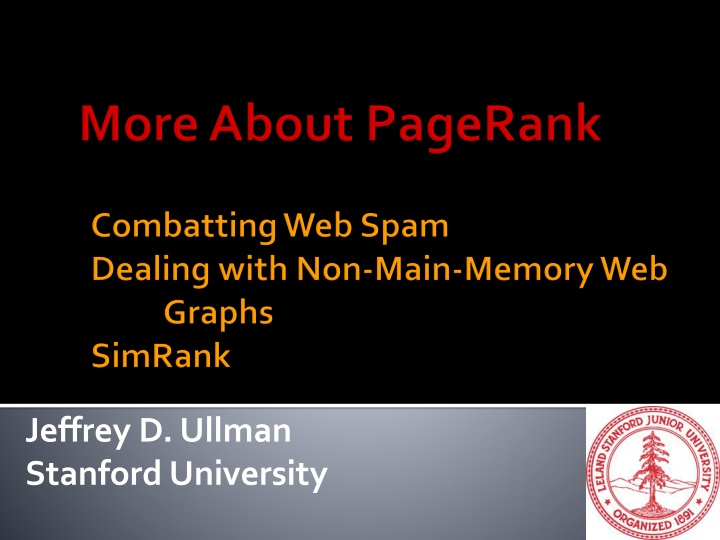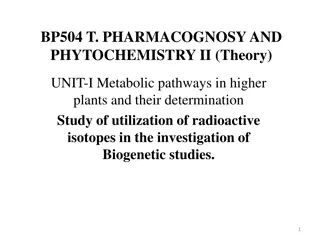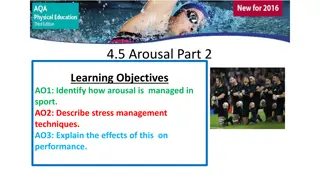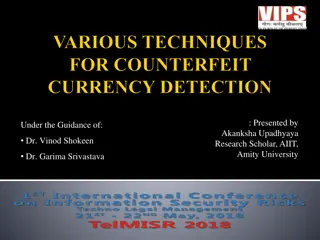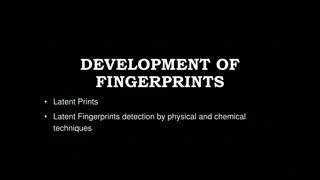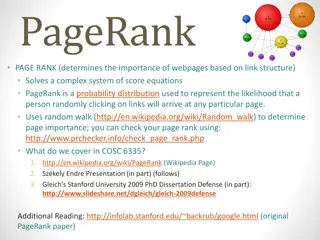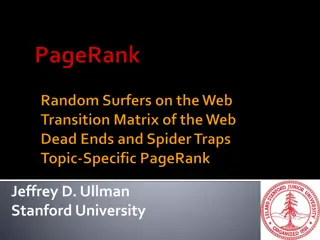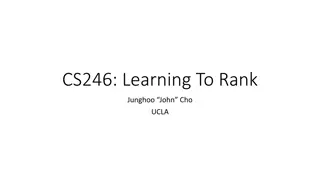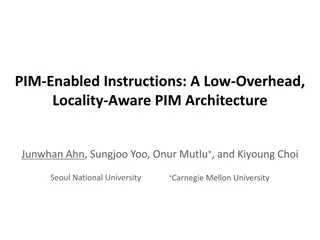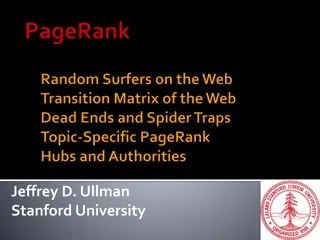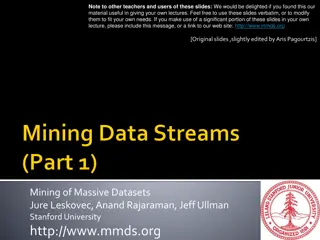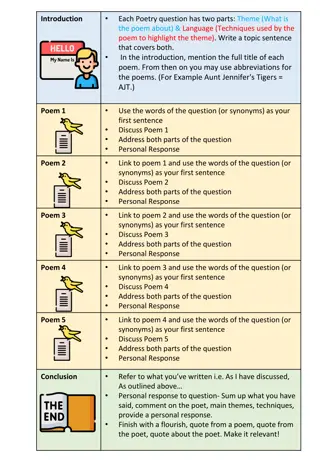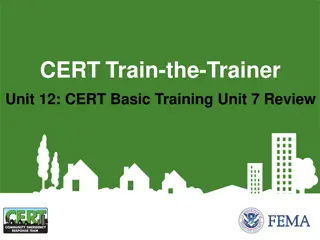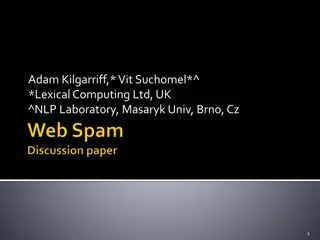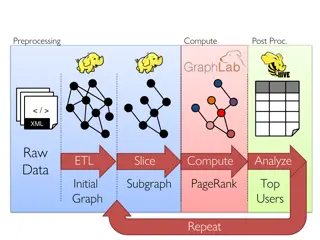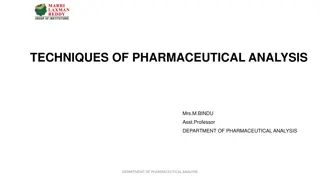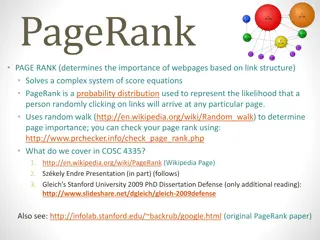Spamming Techniques and PageRank Impact
Spamming refers to deliberate actions aimed at boosting a website's search engine position. Techniques such as term spamming, link spamming, and content dumping are used to manipulate search results. However, PageRank helps prevent spammers from achieving high rankings. Understanding these spamming tactics is crucial for maintaining the integrity of search engine results.
Download Presentation

Please find below an Image/Link to download the presentation.
The content on the website is provided AS IS for your information and personal use only. It may not be sold, licensed, or shared on other websites without obtaining consent from the author.If you encounter any issues during the download, it is possible that the publisher has removed the file from their server.
You are allowed to download the files provided on this website for personal or commercial use, subject to the condition that they are used lawfully. All files are the property of their respective owners.
The content on the website is provided AS IS for your information and personal use only. It may not be sold, licensed, or shared on other websites without obtaining consent from the author.
E N D
Presentation Transcript
Jeffrey D. Ullman Stanford University
Spamming = any deliberate action intended solely to boost a Web page s position in search- engine results. Web Spam = Web pages that are the result of spamming. SEO industry might disagree! SEO = search engine optimization
Boosting techniques. Techniques for making a Web page appear to be a good response to a search query. Hiding techniques. Techniques to hide the use of boosting from humans and Web crawlers.
Term spamming. Manipulating the text of web pages in order to appear relevant to queries. Link spamming. Creating link structures that boost PageRank.
Repetitionof terms, e.g., Viagra, in order to subvert TF.IDF-based rankings. Dumping = adding large numbers of words to your page. Example: run the search query you would like your page to match, and add copies of the top 10 pages. Example: add a dictionary, so you match every search query. Key hiding technique: words are hidden by giving them the same color as the background. 6
PageRank prevents spammers from using term spam to fool a search engine. While spammers can still use the techniques, they cannot get a high-enough PageRank to be in the top 10. Spammers now attempt to fool PageRank with link spam by creating structures on the Web, called spam farms, that increase the PageRank of undeserving pages. 8
Three kinds of Web pages from a spammers point of view: 1. Own pages. Completely controlled by spammer. 2. Accessible pages. E.g., Web-log comment pages: spammer can post links to his pages. I totally agree with you. Here s what I wrote about the subject at www.MySpamPage.com. 3. Inaccessible pages. Everything else. 9
Spammers goal: Maximize the PageRank of target page t. Technique: 1. Get as many links as possible from accessible pages to target page t. Note: if there are none at all, then search engines will not even be aware of the existence of page t. 2. Construct a spam farm to get a PageRank- multiplier effect. 10
Accessible Own 1 Inaccessible 2 t M Note links are 2-way. Page t links to all M pages and they link back. Goal: boost PageRank of page t. Here is one of the most common and effective organizations for a spam farm. 11
Own Accessible 1 2 Inaccessible t M Suppose rank from accessible pages = x (known). PageRank of target page = y (unknown). Taxation rate = 1- Rank of each farm page = y/M + (1- )/N. From t; M = number of farm pages Share of tax ; N = size of the Web. Total PageRank = 1. 12
Tax share for t. Very small; ignore. Own Accessible 1 2 Inaccessible t M y = x + M[ y/M + (1- )/N] + (1- )/N y = x + 2y + (1- )M/N y = x/(1- 2) + cM/N where c = /(1+ ) PageRank of each farm page 13
Own Accessible 1 2 Inaccessible t Average page has PageRank 1/N. c is about , so this term gives you M/2 times as much PageRank as average. M y = x/(1- 2) + cM/N where c = /(1+ ). For = 0.85, 1/(1- 2)= 3.6. Multiplier effect for acquired page rank. By making M large, we can make y almost as large as we want. Question for Thought: What if = 1 (i.e., no tax)? 14
If you design your spam farm just as was described, Google will notice it and drop it from the Web. More complex designs might be undetected, although SEO innovations are tracked by Google et al. Fortunately, there are other techniques for combatting spam that do not rely on direct detection of spam farms. 15
Topic-specific PageRank, with a set of trusted pages as the teleport set is called TrustRank. Spam Mass = (PageRank TrustRank)/PageRank. High spam mass means most of your PageRank comes from untrusted sources you may be link- spam. 16
Two conflicting considerations: Human may have to inspect each trusted page, so this set should be as small as possible. Must ensure every good page gets adequate TrustRank, so all good pages should be reachable from the trusted set by short paths. Implies that the trusted set must be geographically diverse, hence large. 17
1. Pick the top k pages by PageRank. It is almost impossible to get a spam page to the very top of the PageRank order. 2. Pick the home pages of universities. Domains like .edu are controlled. Notice that both these approaches avoid the requirement for human intervention. 18
Google computes the PageRank of a trillion pages (at least!). The PageRank vector of double-precision reals requires 8 terabytes. And another 8 terabytes for the next estimate of PageRank. 20
The matrix of the Web has two special properties: 1. It is very sparse: the average Web page has about 10 out-links. 2. Each column has a single value 1 divided by the number of out-links that appears wherever that column is not 0. 21
Trick: for each column, store n = the number of out-links and a list of the rows with nonzero values (which must be 1/n). Thus, the matrix of the Web requires at least (4*1+8*10)*1012 = 84 terabytes. Integer n Average 10 links/column, 8 bytes per row number. 22
Divide the current and next PageRank vectors into k stripes of equal size. Each stripe is the components in some consecutive rows. Divide the matrix into squares whose sides are the same length as one of the stripes. Pick k large enough to fit a stripe of each vector and in main memory at the same time. Note: We also need a block of the matrix, but that can be piped through main memory and won t use that much memory at any time. 23
w1 M11 M12 M13 v1 = w2 M21 M22 M23 v2 w3 M31 M32 M33 v3 At one time, we need wi, vj, and (part of) Mij in memory. Vary v slowest: w1 = M11 v1; w2 = M21 v1; w3 = M31 v1; w1 += M12 v2; w2 += M22 v2; w3 += M32 v2; w1 += M13 v3; w2 += M23 v3; w3 += M33 v3 24
Each column of a block is represented by: 1. The number n of nonzero elements in the entire column of the matrix (i.e., the total number of out- links for the corresponding Web page). 2. The list of rows of that block only that have nonzero values (which must be 1/n). I.e., for each column, we store n with each of the k blocks and each out-link with whatever block has the row to which the link goes. 25
Total space to represent the matrix = (4*k+8*10)*1012 = 4k+80 terabytes. Integer n for a column is represented in each of k blocks. Possible savings: if a block has all 0 s in a column, then n is not needed. Average 10 links/column, 8 bytes per row number, spread over k blocks. 26
We are not just multiplying a matrix and a vector. We need to multiply the result by a constant to reflect the taxation. We need to add a constant to each component of the result w. Neither of these changes are hard to do. After computing each component wi of w, multiply by and then add (1- )/N. 27
The strategy described can be executed on a single machine. But who would want to? There is a simple MapReduce algorithm to perform matrix-vector multiplication. But since the matrix is sparse, better to treat it as a relational join. 28
Another approach is to use many jobs, each to multiply a row of matrix blocks by the entire v. Use main memory to hold the one stripe of w that will be produced. Read one stripe of v into main memory at a time. Read the block of M that needs to multiply the current stripe of v, a tiny bit at a time. Works as long as k is large enough that stripes (but not blocks) fit in memory. M read once; v read k times, among all the jobs. OK, because M is much larger than v. 29
Mi1 v1 wi Main Memory for job i 30
Mi2 v2 wi Main Memory for job i 31
Mij vj wi Main Memory for job i 32
Unlike the similarity based on a distance measure that we discussed with regard to LSH, we may wish to look for entities that play similar roles in a complex network. Example: Nodes represent students and classes; find students with similar interests, classes on similar subjects. 34
Gus CS246 Ann CS229 Sue Ma55 Joe 35
Intuition: 1. An entity is similar to itself. 2. If two entities A and B are similar, then that is some evidence that entities C and D connected to A and B, respectively, are similar. 36
Gus CS246 Ann CS229 Sue Gus, Ann Ma55 Joe CS246, Ma55 Gus, Sue CS246, CS229 Ann Gus, Joe Three others 37
You can run Topic-Sensitive PageRank on such a graph, with the nodes representing single entities as the teleport set. Resulting PageRank of a node measures how similar the two entities are. A high tax rate may be appropriate, or else you conclude things like CS246 is similar to Hist101. Problem: Using node pairs squares the number of nodes. Can be too large, even for university-sized data. 38
Another approach is to work from the original network. Treat undirected edges as arcs or links in both directions. Find the entities similar to a single entity, which becomes the sole member of the teleport set. Example: Who is similar to Sue? on next slides. 39
Gus CS246 Ann CS229 1.000 Sue Ma55 Joe 40
Gus CS246 Ann .400 CS229 .200 Sue Ma55 .400 Joe 41
Gus CS246 .107 Ann .080 CS229 .467 Sue Ma55 .080 .267 Joe 42
Gus .048 CS246 .021 Ann .336 CS229 .253 Sue Ma55 .294 .053 Joe 43
.019 Gus .008 CS246 .109 Ann .131 CS229 .407 Sue Ma55 .112 .207 Joe 44
